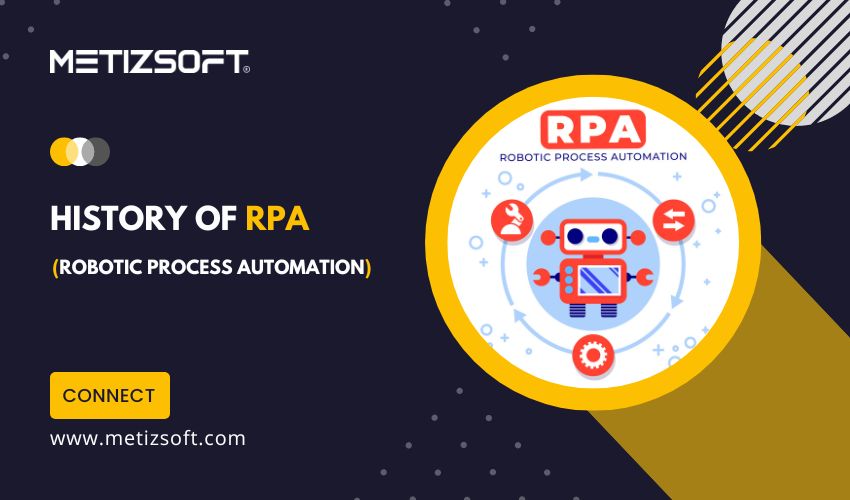
Much like human evolution, technology has also undergone numerous stages to come this far. If you explore modern technology inside-out, you will see a lineage of predecessors of machines, software, systems, and servers. The ones dominating today were once figments by a few geniuses and crazy minds.
Robotic Process Automation, aka RPA, is no exception. It was long forged alongside Machine Learning (ML) and Artificial Intelligence (AI). With each upgrade, RPA becomes the key talk in the digital world. Today, RPA has been the driving workforce for many enterprises and industries. It has become integral to business operations, ensuring high-end efficiency, cost-saving, and compatibility.
This blog post traces the history of RPA and its adoption over time, highlighting its role in accelerating the digital transformation of businesses.
Table of Contents
RPA History!
RPA is a toolkit that combines different automation technologies for various purposes. Although the term ‘RPA’ emerged in the early 2000s, its development began in the 1990s.
During the early 2000s, Robotic Process Automation (RPA) emerged as an up-and-coming technology. At the time, it relied on artificial intelligence, screen scraping, and workflow automation. However, RPA has significantly expanded its capabilities beyond its initial limitations since then.
To better understand the RPA history, let’s trace back to its beginning stage from the 90s to the date.
90s – Automation in UI Testing
Back then (In the 90s), only a few computer models were on the market. However, the typical computer user persona shifted from employees of giant corporations and governmental organizations to ordinary home-based users. As a result, the concept of UI testing development kickstarted to diversify the screen sizes of systems.
The story and implementation of RPA started with this UI testing automation. The automation role is to test visual elements of interfaces, ensuring they work correctly and a user won’t encounter any issues with the app.
By the end of the 90s, organizations and industries started to learn and understand the agile development concept. It then gave the vital push-up to various automation concepts.
20s – Automation in Banking & Finanace!
After the introduction, automation didn’t get much attention from everyone. It was a new concept, and business owners were unsure about it. One of the primary reasons for this hesitation is its drawbacks.
For example, If a company wanted to automate its processes in the past, it would often result in creating a complex IT infrastructure.
However, banking and insurance institutions dared to implement automation in their business operations. The primary reason behind this decision is the hindrances they faced when handling that large amount of data. It was hard to manage and configure everything humanly, and errors were bound to happen.
Another reason is screen scraping—the biggest and most valuable asset of automation, which ensures seamless automation of data extraction from applications. This approach has proven successful for them, significantly enhancing the efficiency, accuracy, and effectiveness of businesses managing vast amounts of data.
2010s – Enterprise Automation
The complete emergence and domination of Robotic Process Automation happened in 2010 and post-era. It is when large-scale enterprises understand and adopt it officially to run their business operations. Many incidents and factors lead them to this decision, such as:
- Digital Transformation – Businesses in this period underwent rapid digital transformations. Entrepreneurs and owners are looking for a reliable and cost-effective solution to run their business, and RPA fits into their budget and usage.
- Financial Crisis – Due to the sudden financial crisis, businesses sought ways to reduce expenses and RPA is the best way out.
These two vital factors led RPA to the market, allowing numerous enterprises to fully embrace its capabilities to conquer critical tasks with minimum investment.
2020s – RPA Continues its Dominance!
The 2020s belong to RPA! One must have a strong alternative and supreme reason to deny this statement. When the world suffered from the COVID-19 crisis, RPA became a primary asset for enterprise and industry owners. It is when small and mid-cap businesses started to implement their business model. The expansion of RPA to smaller business industries leads to massive productivity outcomes.
Since the pandemic forced millions of employees and CEOs to work from home, video meetings and conferences have become the norm. However, these individuals are no longer satisfied with monotonous jobs. Instead, they crave exciting and challenging tasks.
Fortunately, companies can leverage RPA bots to automate the work of various departments and specialists. Employees become more efficient when automation is implemented effectively for tedious and repetitive tasks.
Future of Robotic Process Automation (RPA)
End-to-end automation has advanced significantly recently and has become a popular trend. The growth can be attributed to the RPA service models, where the
RPA as-a-service segment in 2020 had the highest market share, accounting for over 61%, and showed the highest growth rate.
The global market for RPA was valued at USD 2.3 billion in 2022. It is projected to grow at a 39.9% CAGR from 2023 to 2030, as per the Grand View Research report.
These stats are enough to showcase the shining future of Robotic Process Automation. RPA has exciting times ahead with more adoption from industries of all sizes and niches. Hence, seeing how it maintains its dominance with every upgrade will be interesting.
Bottom Line
The history of Robotic Process Automation is now a case study filled with many myths and interesting facts. Today, the ultimate fact is that RPA manages the business with complete authority. Many industries are turning to Robotic Process Automation (RPA) to improve business activities by making processes more efficient and scalable.
RPA is a superior technology that offers many benefits and is easy to implement. It has become increasingly popular due to its ability to streamline processes and reduce costs.
If you are considering RPA for your company, Metizsoft Solutions will guide you. We feature the most experienced and agile team of RPA Experts who can help start your RPA journey on the business terms that will take your business to the next level.
AboutManthan Bhavsar
Related Posts
What is RPA: 6 Essential Facts for Robotic Process Automation
The ongoing and rapid shift toward Artificial Intelligence (AI) and automation is comprehensively reshaping the modern...
Unleashing Efficiency: Streamline IT Operations with RPA!
Organizations tirelessly seek ways to optimize operations and boost productivity in today’s fast-paced digital...



